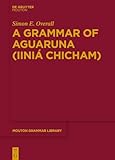A Grammar of Aguaruna (Iiniá Chicham) / Simon E. Overall.
Material type: TextSeries: Mouton Grammar Library [MGL] ; 68Publisher: Berlin ; Boston : De Gruyter Mouton, [2017]Copyright date: ©2017Description: 1 online resource (XVI, 636 p.)Content type:
TextSeries: Mouton Grammar Library [MGL] ; 68Publisher: Berlin ; Boston : De Gruyter Mouton, [2017]Copyright date: ©2017Description: 1 online resource (XVI, 636 p.)Content type: - 9783110405576
- 9783110405590
- online - DeGruyter
- Issued also in print.
| Item type | Current library | Call number | URL | Status | Notes | Barcode | |
|---|---|---|---|---|---|---|---|
 eBook
eBook
|
Biblioteca "Angelicum" Pont. Univ. S.Tommaso d'Aquino Nuvola online | online - DeGruyter (Browse shelf(Opens below)) | Online access | Not for loan (Accesso limitato) | Accesso per gli utenti autorizzati / Access for authorized users | (dgr)9783110405590 |
Browsing Biblioteca "Angelicum" Pont. Univ. S.Tommaso d'Aquino shelves, Shelving location: Nuvola online Close shelf browser (Hides shelf browser)

|

|

|

|

|

|

|
||
| online - DeGruyter Buchgeschichte : Eine Einführung / | online - DeGruyter Guide to Reprints : An International Bibliography of Scholarly Reprints. 2016, Author Title and Subject Guide. | online - DeGruyter Frequency Effects In Instructed Second Language Acquisition / | online - DeGruyter A Grammar of Aguaruna (Iiniá Chicham) / | online - DeGruyter Das konfessionelle Zeitalter / | online - DeGruyter Lateinische Grammatik / | online - DeGruyter Abrahams Erbe : Konkurrenz, Konflikt und Koexistenz der Religionen im europäischen Mittelalter / |
Frontmatter -- Acknowledgements -- Table of contents -- Abbreviations and conventions -- Maps -- 1 Introduction to the Aguaruna language -- 2 Cultural and historical context -- 3 Phonology -- 4 Morphology of nouns, adjectives and pronouns -- 5 The noun phrase -- 6 The verb -- 7 Grammatical relations and transitivity -- 8 Tense, aspect and person in finite verbs -- 9 Mood and modality -- 10 Questions -- 11 Negation -- 12 Adverbial words -- 13 Subordinate clauses -- 14 Clause chaining and clause combining -- 15 Nominalization -- 16 Relative clauses -- 17 Speech reports and complement clauses -- 18 Discourse organization -- Text 1: A man is eaten by a boa -- Text 2: Extracts from Pablo’s autobiography -- Text 3: Hunting -- References -- Index
restricted access online access with authorization star
http://purl.org/coar/access_right/c_16ec
This book is a descriptive grammar of Aguaruna, known to its speakers as Iiniá Chicham, a Jivaroan language spoken by some 55,000 people in the northwest Peruvian Amazon. Aguaruna is typologically and historically significant because of its location in the eastern foothills of the Andes, right between the Andean and Amazonian linguistic areas. Some typologically unusual syntactic phenomena, for example in the areas of grammatical relations and case marking, make this description relevant beyond the areal context. This is the first full grammar of a Jivaroan language, covering phonology, morphology and syntax as well as addressing some issues in discourse structure. It is an important work for specialists in South American languages as well as for linguists working in more general typological fields.
Issued also in print.
Mode of access: Internet via World Wide Web.
In English.
Description based on online resource; title from PDF title page (publisher's Web site, viewed 28. Feb 2023)


